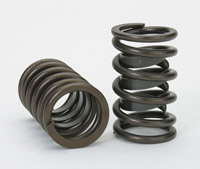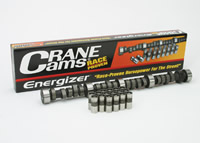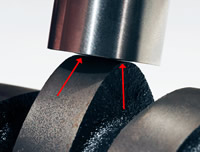Engine Oil Deep Dive - CAC's Comprehensive Look at Engine Oil and Flat-Tappet Camshaft Durability - Page 4 of 6
 |
 |
© 2009 by Hib Halverson
No use without permission, All Rights Reserved
![]() Discuss this article
Discuss this article
IIIG Validates Flat Tappet Durability
For 50 years, American Society for Testing and Materials (ATSM) "Sequence III Engine Oil Certification Tests" has been used to validate an oil's ability to properly lubricate production flat tappet cams.
For about the last decade, Sequence III has been performed with a General Motors 3800 Series II V6. Since all 3800s have roller lifters, the test engines are retrofitted with flat tappet cams and valve spring pressure of about 205 pounds open or, with the 3800's 1.67:1 rocker ratio, 328 lbs at the lifter. While that spring pressure is not overly high by V8 standards, it is higher than stock for a 3800. Additionally, the V6's camshaft base circle is smaller and that further increases load at the lobe/lifter interface beyond what a V8 would sustain from the same spring pressure. These measures were taken to increase load at the lobe/lifter interface to 180,000 psi.
SAE's Technical Paper How Much ZDP is Enough describes the test's operating conditions as, "...designed to simulate a flat tappet, OHV pushrod engine in a pickup truck pulling a loaded cattle trailer across the desert on a hot day."
The current version, IIIG, optional for GF-3 and required for GF-4 certification, specifies that the engine run at 3600 rpm and be loaded such that its output is about 80% of its rated torque. It is run with 95° intake air temperature, 239°F coolant temperature and 302°F oil temperature. The test lasts for 100 hours with brief stops every 20 hours to check oil level. After the test, the engine is disassembled and the cam and lifters are precisely measured for wear.
Regardless of any fairy tales one reads on the Internet or in magazines, the Sequence IIIG test, especially the 302° oil temperature, is brutal - more severe than the IIIF and IIIE sequences that proceeded it and far more severe than any tests of flat tappet cam/lifter wear to which any engine oils for use in gasoline engines of any period prior to 1993 were subjected.
That said, there are a couple of limitations of Sequence IIIG: 1) it doesn't take into account aftermarket cams which received phosphate coatings of a lesser quality than was typical of OE cams from the mid-'50s until 1986 and 2) it's not relevant to valvetrains with loads higher than stock.
ZDP Bottomline
If you haven't picked-up on it yet, there is an urban legend in the car hobby which has been widely repeated by word-of-mouth, on the Internet,by companies marketing additives such as "ZDDP Plus" and, to a lesser extent, even in a few Corvette magazines. That big, fat myth is that zinc dithiosphate ("ZDP", "ZDDP", "zinc", etc.) has been "eliminated" from today's engine oils.
Reality is: ZDP remains in all engine oils marketed for use in gasoline and diesel engines in ground vehicles and will continue to be in them for the foreseeable future.
Wear Raises its Ugly Head
Amongst the first to sound the alarm about oil-related failures of flat tappet cams and lifters was the Crane Cams subsidiary of Crane Technologies Group, Inc. Chase Knight, Crane's Valvetrain Products Manager, told the CAC in an interview in late 2008, "In the late-'90s we started to see evidence of oil-related failures with street-driven, racing cam-shafts. Our hardcore racing customers understood break-in procedures and used premium lubricants, so it wasn't as noticeable among that group.
"We were fortunate that the wife of a fellow we worked with was employed by a major oil company and provided us with information that ZDP content was changing, but many people - our customers - did not want to believe it."
Sources at Joe Gibbs Racing, a top NASCAR team, told us that, starting in 1999, there were cam failures both on its engine shop's dynamometers and on the race track. and reduced ZDP oil was a contributory cause.
Other cam companies noted problems, as Comp Cams' Billy Godbold stated, "In 2000, we started pushing 'Cam Break-In' (Comp's assembly/break-in lube) but we saw problems before that with Ford Pintos (2.3L SOHC inline-4). Then, it started to creep up in the '02-'03 period with significant problems evident by '05 and '06."
One knee jerk reaction was to blame oil companies, but is it all big oil's fault? Or is its culpability mitigated by: automotive manufacturers', pressuring it to reduce zinc dithiophosphate (ZDP) for increased catalytic converter life, the aftermarket's technology advances putting more load on cams and lifters, parts quality problems and user mistakes?
Let's review our "phosphorous timeline": mid-'50s to mid-'70s, enough ZDP was in mass-marketed oils to result in about 800 PPM phosphorous, a number proven adequate back then for stock engines and even some with aftermarket cams.
Mid-'70s to late-'80s, phos content rose to about 1000 PPM in response to perceived EP lubricant needs of engines with finger followers. As that need later proved unfounded, as car companies converted to roller lifters and as catalytic converter life became a concern; in the early-90s, phos content moved back towards 800 PPM. Mass-marketed, ILSAC or API S-Service Category engine oils with viscosities 10W30 or less remained at that phosphorous level until about the time ILSAC GF-4 was announced in January of 2004.
Aftermarket Cams
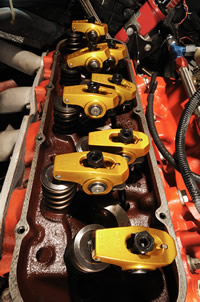
One factor affecting the camshaft wear problem has been the widespread acceptance by Corvette performance enthusiasts of rocker arms with higher than stock ratios. An example are these Crane, 1.8:1, roller rockers on a Big-Block in a hot rod, '71 Coupe. Higher ratio rockers increase loads at the lobe/lifter interface. The increased loads require engine oil with high phosphorous content or the cam and lifters will fail.
Image: Author
"Racing cams" have been available since the late-1940s. Yet, until the late-'90s, there was no widespread valvetrain durability problem with racing cams caused by inadequate EP additives in oil.
In the '80s the aftermarket camshaft industry developed more aggressive profiles. That and more valve spring pressure combined to increase loads at the lobe/lifter interface. With phosphorous content up from 800 towards 1000 PPM, as long as they followed proper installation and break-in procedures, Corvetters running those cams in street engines filled with mass-marketed oils typically did not experience durability problems, in spite of the increased need of EP lubrication driven by the higher loads.
In the '90s, the situation was different. While advancing technology, especially the popularity of higher ratio rocker arms, continued the slow increase in lobe/lifter loads; the phosphorous content in oils reversed its trend and slowly decreased back towards 800 PPM. All the while, people disregarding cam manufacturers' break-in procedures continued their foolish ways.
Previously, 800 PPM phos wasn't an issue because, in the '70s, no one ran loads at the cam/lifter interface as high as some people did in the mid-1990s. By 1999-2000, wear driven failures, especially of racing cams in street engines filled with mass-marketed oil, were mounting.
Few forecast the "perfect storm" which was brewing.
Tipping Point: Lousy Lifters and GF-4
Manufacturing high quality, flat-faced lifters is a difficult, specialized process. That the units for OHV engines were less in demand and economy-of-scale is why, by the '90s, none of the camshaft makers, also, made flat tappets.
Earlier this decade, two events caused the cam/lifter problem to explode. First, two of the four manufacturers of high-quality, flat tappets ceased production. Eaton exited the market and Hylift-Johnson went bankrupt. The third, Stanadyne Corporation, did not take up the slack and the fourth, Delphi, was exclusive to GM. Two suppliers disappearing at the same time and the third maintaining production rate, created a serious shortage.
"We get lifters primarily from Stanadyne," Crane's Chase Knight told us. "While Stanadyne had trouble meeting demand, we couldn't get as many as we wanted.
"There were times we had to explain to people, 'Sure you can buy a flat tappet cam, but we're not in a position to sell lifters. You'll have to make an educated choice as to where to obtain lifters.'
"We weren't about to sell any of the substandard pieces. That would not have benefitted us at all. As I've stated publicly, before, 'I'd rather sell nothing, than sell junk.'"
Other quality-driven cam makers either had a better supply situation or adopted an attitude similar to Crane's. While Hylift-Johnson was back in business by '04 and Stanadyne eventually increased production, in the interim, inferior substitutes from foreign sources known as "tray", "brown-bag" or "white box" lifters flooded the market. How did lousy lifters get into unsuspecting Corvette owners' engines?
"Off-brand" or "private label" camshafts are a thriving market. Most of their vendors don't manufacture anything, offer low prices and sell by mail, phone or Internet. Some buy cams from one source and lifters from another with the choice of sources based on cost. Additionally, some consumers might buy a cam from Crane but get swap meet lifters from some cheesy guy who "...just got a shipment in from Pakistan."
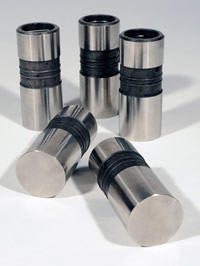
Flat-faced valve lifters, either solid or hydraulic, look simple, but they're not. Lifters for flat-tappet engines are difficult to make. The proper machining of a hydraulic lifter's internal parts and the proper machining of hydraulic or solid lifter faces are some of the most demanding tasks in automotive parts manufacturing.
Image: Author
Cheap parts sources, sensing profit like sharks sense blood and knowing their prices and availability would attract vendors of off-brand parts and even some name brands, filled the void left by Eaton and Hy-Lift Johnson in spite of their inability, or, in some cases, unwillingness, to make lifters with quality matching products from reputable suppliers. In fairness, some retailers of these cheap parts were unaware of the poor quality, but a few probably were aware. Either way, the result was a larger proportion of crummy lifters failed than would have as a result of the problem with oil, alone.The second part of this 1-2 punch of was ILSAC GF-4 and API Service SM be coming effective in 2005. GF-4 oils having viscosities of 10W30 or less were required to hold phosphorous between 600 and 800 PPM with most at 700-750. Using a GF-4 oil with an aftermarket, flat-tappet racing cam was asking for trouble. If the engine was, also, fitted with "brown bag" lifters, failure simply occurred sooner.
Four Rules
1) ILSAC GF-4/API Service Category SM oils have adequate ZDP for nearly all stock, flat-tappet Corvette engines including the LT5, which are broken-in and in good condition. The few exceptions are rare late-'60s/early-'70s engines (ZL1, L88, L89, LT1, 427/435-hp, 327/375-hp and etc) with factory, special high performance, cams. For them, see Rule 2.
2) DO NOT use any 0W-20, 5W-20, 5W-30 or 10W30 oil certified to GF-4 in flat-tappet engines fitted with any of: aftermarket street-high-performance or racing cams, valve springs with higher than stock pressure, higher ratio rocker arms or factory special performance camshafts. Engines with any of that require oil with enough ZDP to make no less than 1000 PPM phosphorous and 1100-1200 is desirable.

Perhaps the best hydraulic flat-tappet you can put in a Corvette engine is sold through the GM Performance Parts program. This lifter (PN 12371044) is a unique cast iron and steel composite design manufactured by Delphi using a proprietary process. It is, also, the lifter in the engines used for the Sequence IIIG test discussed in Part One of this series.
Image: GM Communications
3) Appropriate viscosity for the majority of Corvette engines is 10W30. A few old school race engines with large clearances, big-blocks with forged pistons and so forth-can use 10W40s. More than that is unnecessary and provides no performance or durability advantage. In fact, 15W50s or 20W50s increase oil temperature because the oil pump works the oil harder. The only exceptions are engines in very poor condition or some unusual racing configurations, say...a blown alcohol, drag race motor.
4) When new flat tappet cams and lifters are are installed, proper assembly and break-in procedures are an absolute necessity.
Solutions
One good solution - an expensive one we'll admit - is to convert your flat-tappet engine to roller lifters, however, we think virtually all who've have read this far have decided to stay with a flat-tappet cam and are looking for an oil solution, not a hardware solution.
Oil for flat-tappet engines having highly-loaded valvetrains may be certified other than ILSAC GF-4/API SM, however, those other certifications regulate maximum phosphorous not minimum. There are, also, excellent oil choices which are not certified at all. Lack of certification may, in fact, be desirable because it allows reputable makers of premium lubricants to quickly adopt new technology and, no matter what kind of cam is in an engine, blend oils without performance or durability compromises.
The challenge is determining what phosphorous content a given engine oil has. Some refiners publicize that information, but many do not. There are hundreds of brands of oil. It wasn't practical to contact all their makers, however, we did obtain phos data on a few products from companies which make contents information readily available. From that, we developed some oil suggestions.
The least expensive oils for engines with aftermarket valve train parts or a factory racing cam are petroleum-based products for passenger car and light truck diesel engines. The most practical, because it's available in quarts, is Shell "Rotella T" 10W30. It's nominal phosphorous content is 1100 PPM and we've seen it street priced under three bucks a quart. Another is Chevron's new, "Delo 400 LE" 10W30 which, also, has 1100 PPM phos. At this writing, the smallest quantity available is a gallon jug. Both are certified API CJ-4 and SM, but the quirky API licensing is such that, when an oil is first certified CJ-4, it's exempted from SM's max. phos restriction. There have been rumors that a new, lower-phos diesel engine oil standard is soon to come, but the ILSAC Oil Committee's Chair, Robert Olree, told us in an interview that is not true. No follow on standard to CJ-4 is even being considered by ILSAC at this time.
 |
 |
